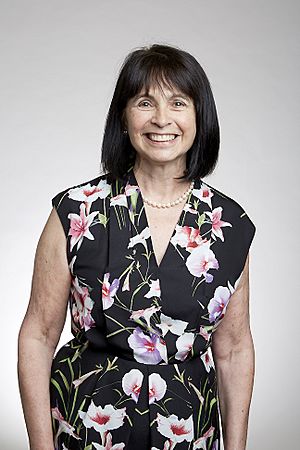Susan R. Wessler facts for kids
Quick facts for kids
Susan Wessler
|
|
|---|---|

Susan Wessler at the Royal Society admissions day in London, July 2017
|
|
| Born |
Susan Randi Wessler
1953 (age 71–72) New York City
|
| Education |
|
| Awards | ForMemRS |
| Scientific career | |
| Institutions |
|
| Thesis | In vitro and in vivo expression of the leucine operon of Escherichia coli and Salmonella typhimurium (1980) |
Susan Randi Wessler is a well-known American scientist. She was born in 1953 in New York City. Dr. Wessler is a plant molecular biologist and geneticist. This means she studies the tiny parts of plants, like their DNA and genes. She is a distinguished professor at the University of California, Riverside (UCR).
Contents
Education and Early Life
Susan Wessler showed her talent for science early on. She graduated from the Bronx High School of Science in 1970. This school is famous for its focus on science and math.
College and Advanced Degrees
After high school, she continued her studies. She earned her bachelor's degree in Biology in 1974. She got this degree from the State University of New York at Stony Brook. Later, she went on to get her Ph.D. in Biochemistry. She completed her Ph.D. at Cornell University in 1980.
Career and Scientific Discoveries
After finishing her education, Dr. Wessler began her research career. She worked as a postdoctoral research fellow at the Carnegie Institution of Washington. This was from 1980 to 1982.
Becoming a Professor
In 1983, she joined the University of Georgia (UGA). She started as an assistant professor of botany, which is the study of plants. She became a full professor in 1992. Her hard work led to her being named a distinguished research professor in 1994. By 2005, she was a regents professor.
Inspiring Future Scientists
In 2006, Professor Wessler became a Howard Hughes Medical Institute (HHMI) Professor. This special role allows her to combine her research with teaching. She is also a professor at the Keck Graduate Institute in California.
Understanding Jumping Genes
Dr. Wessler's research mainly focuses on "transposable elements". These are often called "jumping genes." They are bits of DNA that can move around within a plant's genome. Her work helps us understand how these jumping genes contribute to how genes and genomes change over time.
Her lab found out how these elements create genetic diversity. They do this without harming the plant. For example, her team showed that some jumping genes can act like introns. Introns are parts of a gene that get cut out. They also discovered that "retrotransposons" are a main cause of new changes in maize (corn).
Using Computers in Research
In the age of genomics, her lab was a leader in using computers. They used computers to study transposable elements. This led to the discovery of miniature inverted repeat transposable elements (MITEs). These MITEs are often found near plant genes.
The Dynamic Genome Program
As an HHMI Professor, Dr. Wessler created a special program. It is called the Dynamic Genome Program. This program lets new college students experience real scientific discovery. They get to work on actual research projects.
Awards and Recognitions
Dr. Susan Wessler has received many important awards for her work. These awards recognize her contributions to science.
- She was elected a Foreign Member of the Royal Society (ForMemRS) in 2017.
- She became a member of the American Philosophical Society in 2013.
- In 1998, she was elected a member of the National Academy of Sciences. She also served on its council.
- She was elected a fellow of the American Association for the Advancement of Science in 2006.
- In 2007, she became a fellow of the American Academy of Arts and Sciences.
- She received the American Society of Plant Biologists' Stephen Hales prize in 2011.
- In 2012, she was given the FASEB Excellence in Science Award.
- She won the McClintock Prize for Plant Genetics and Genome Studies in 2015.
- In 2019, she received the HudsonAlpha Institute for Biotechnology Life Sciences Prize.

